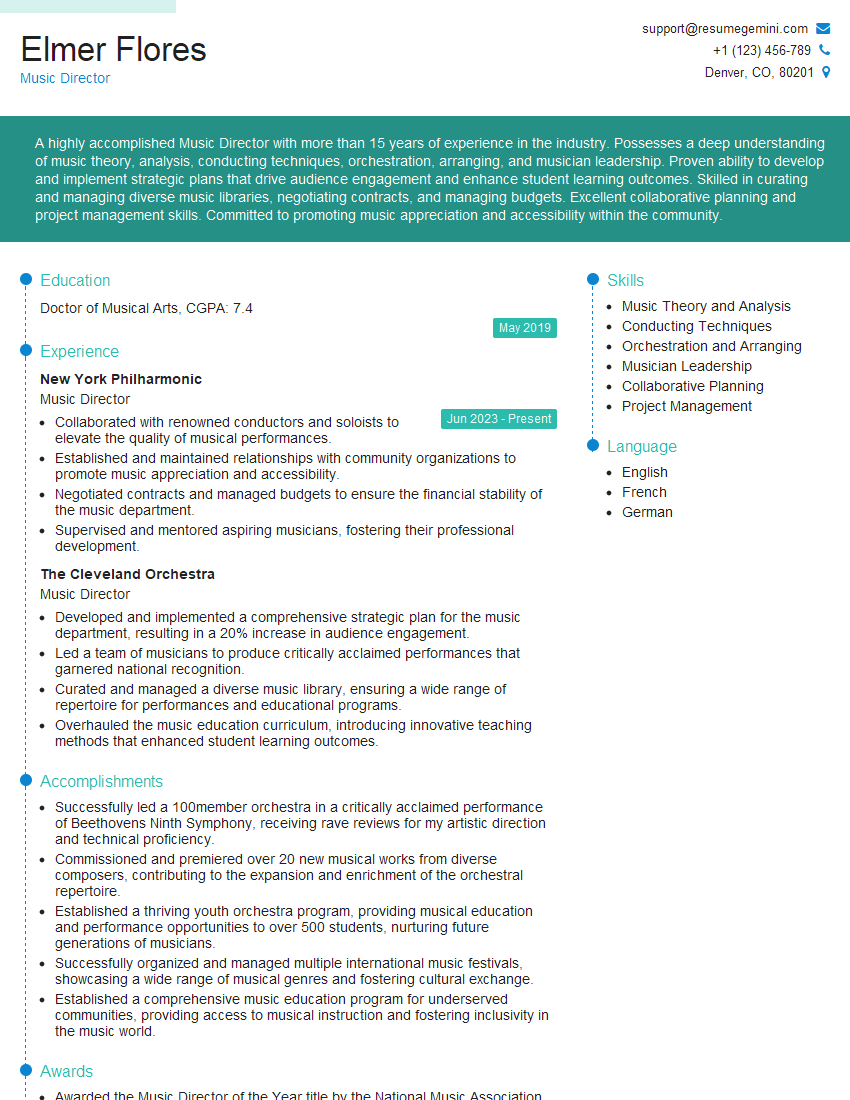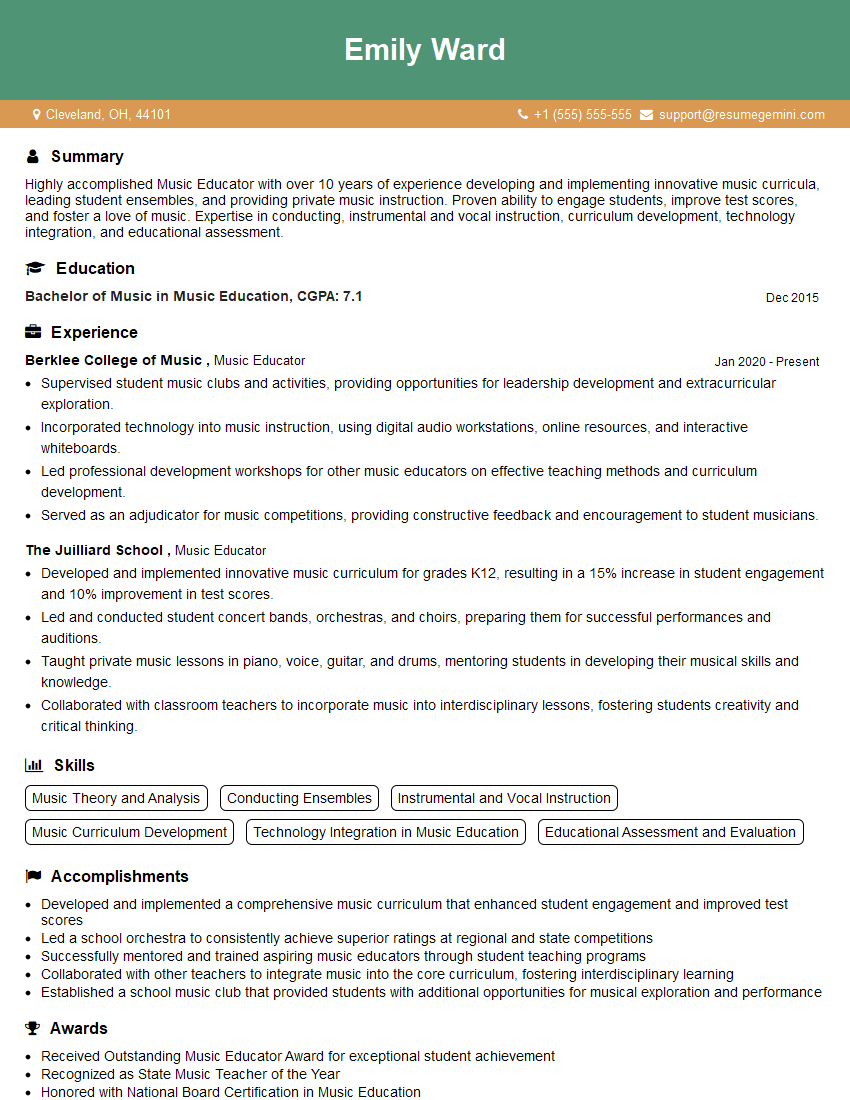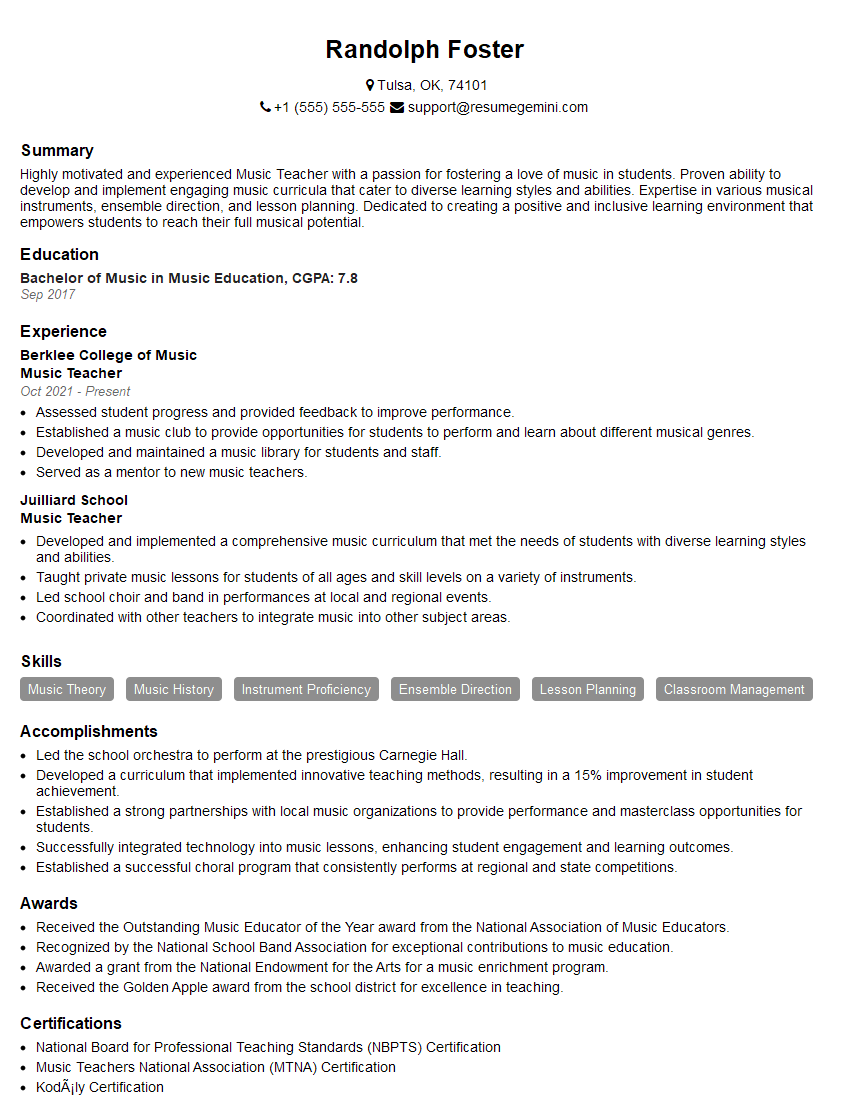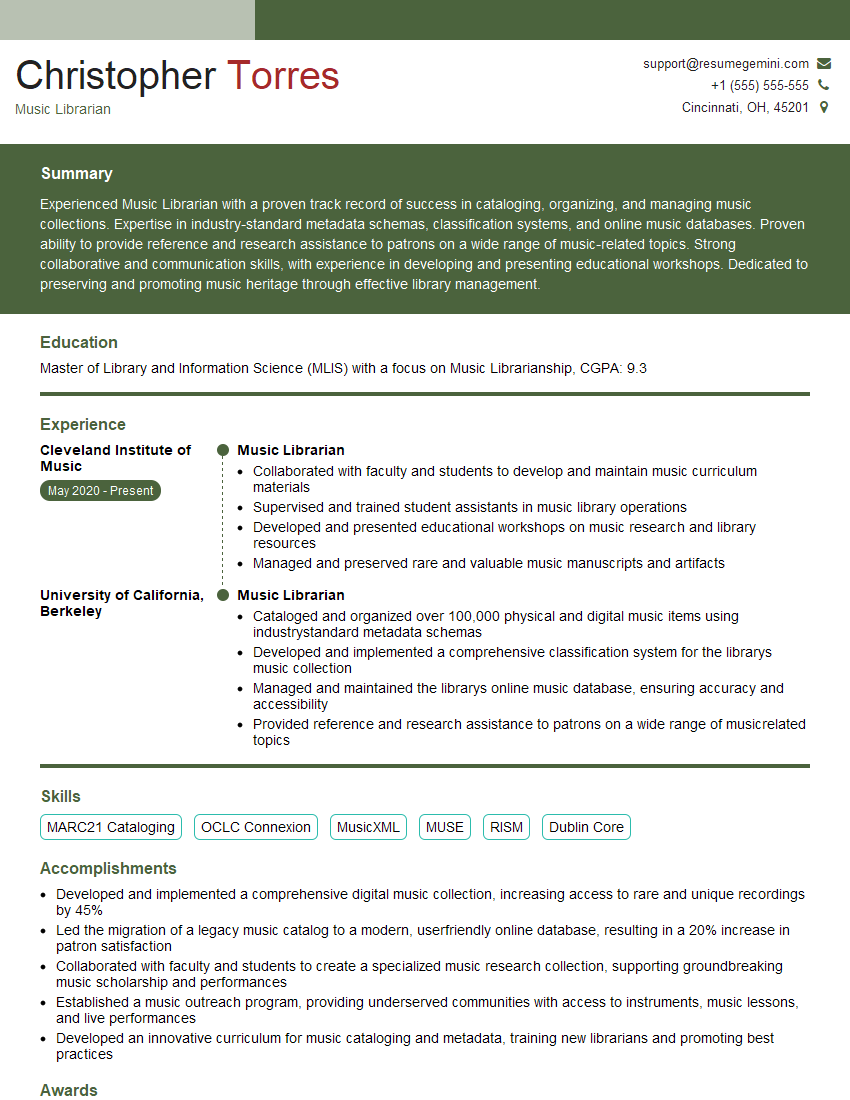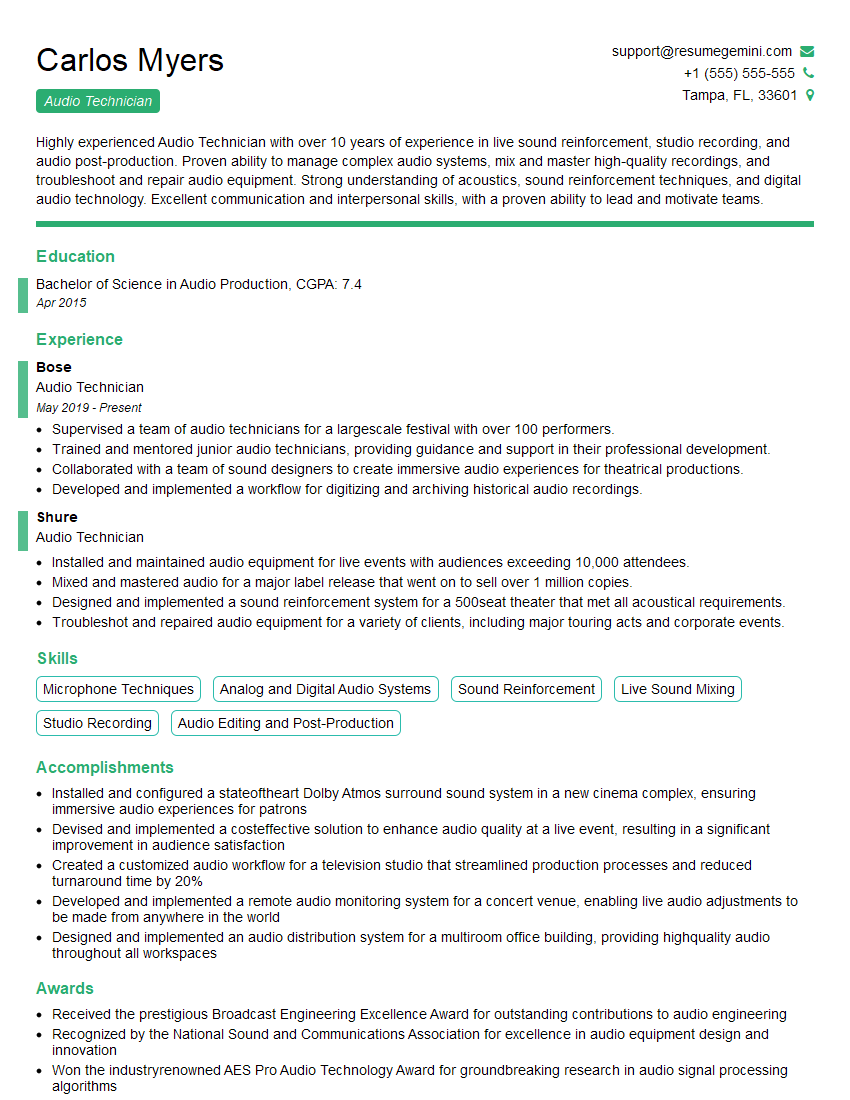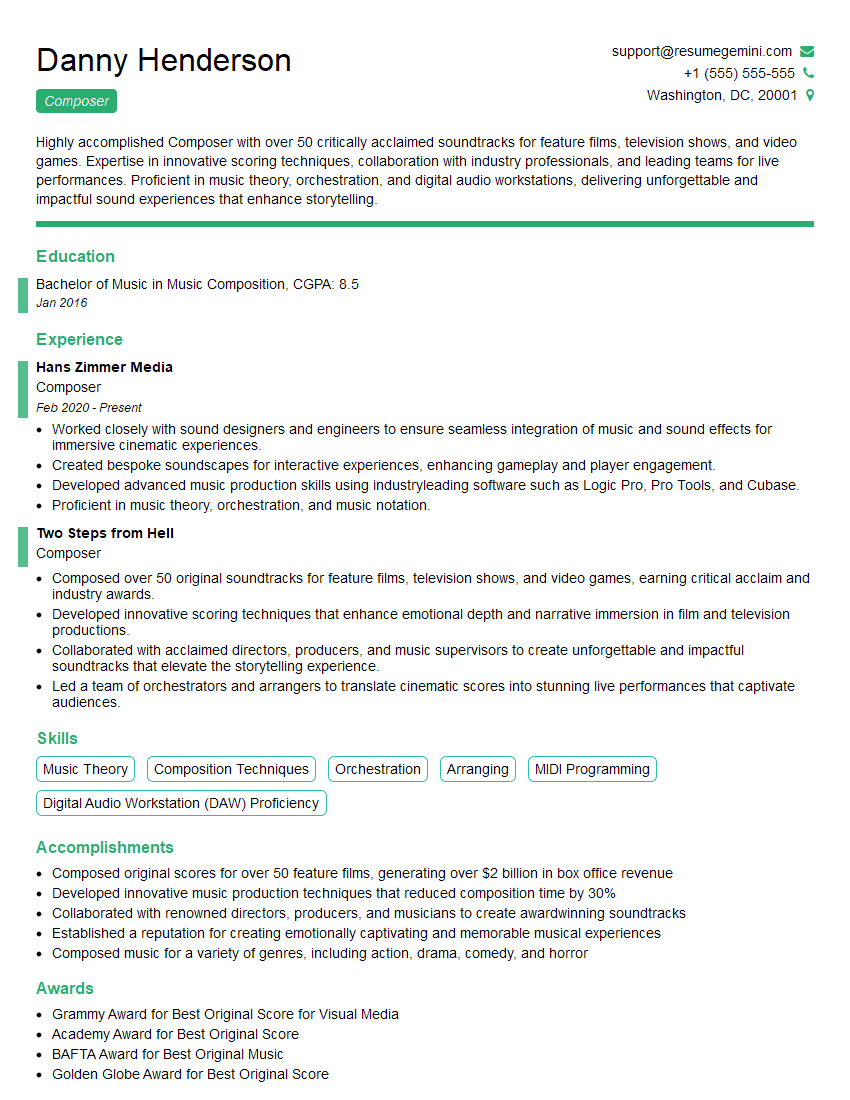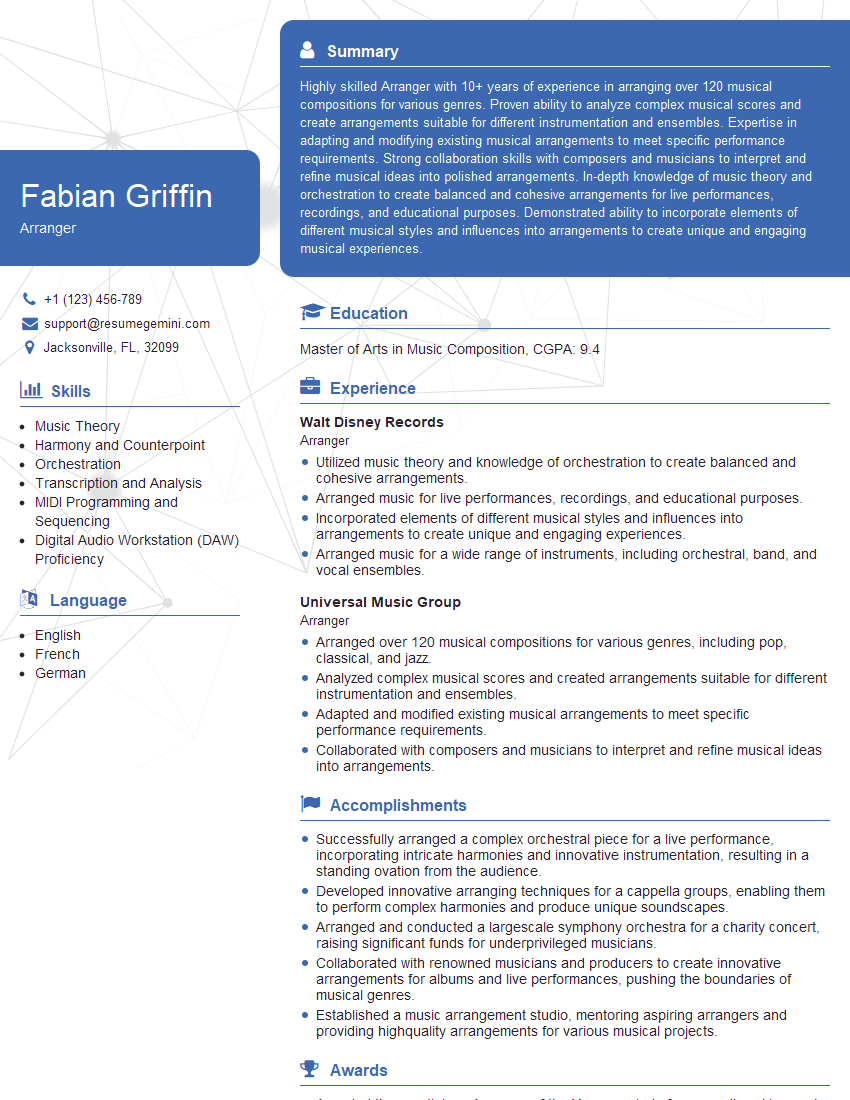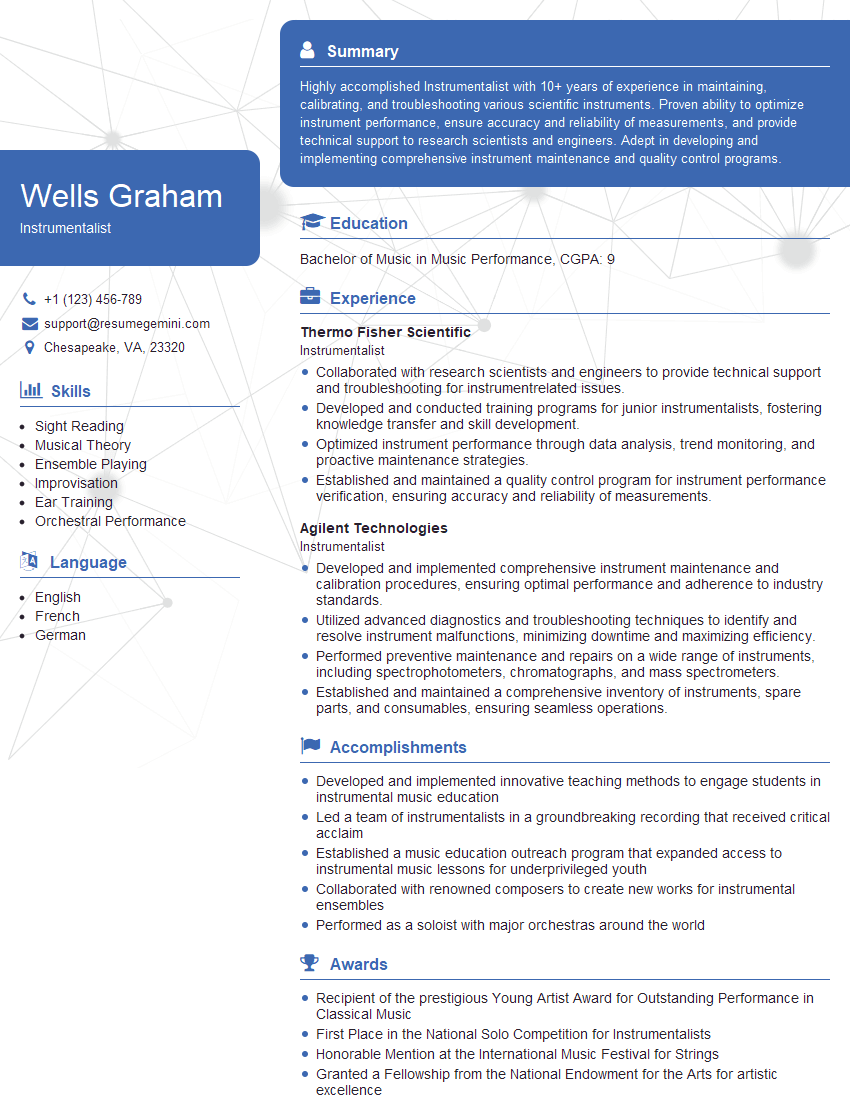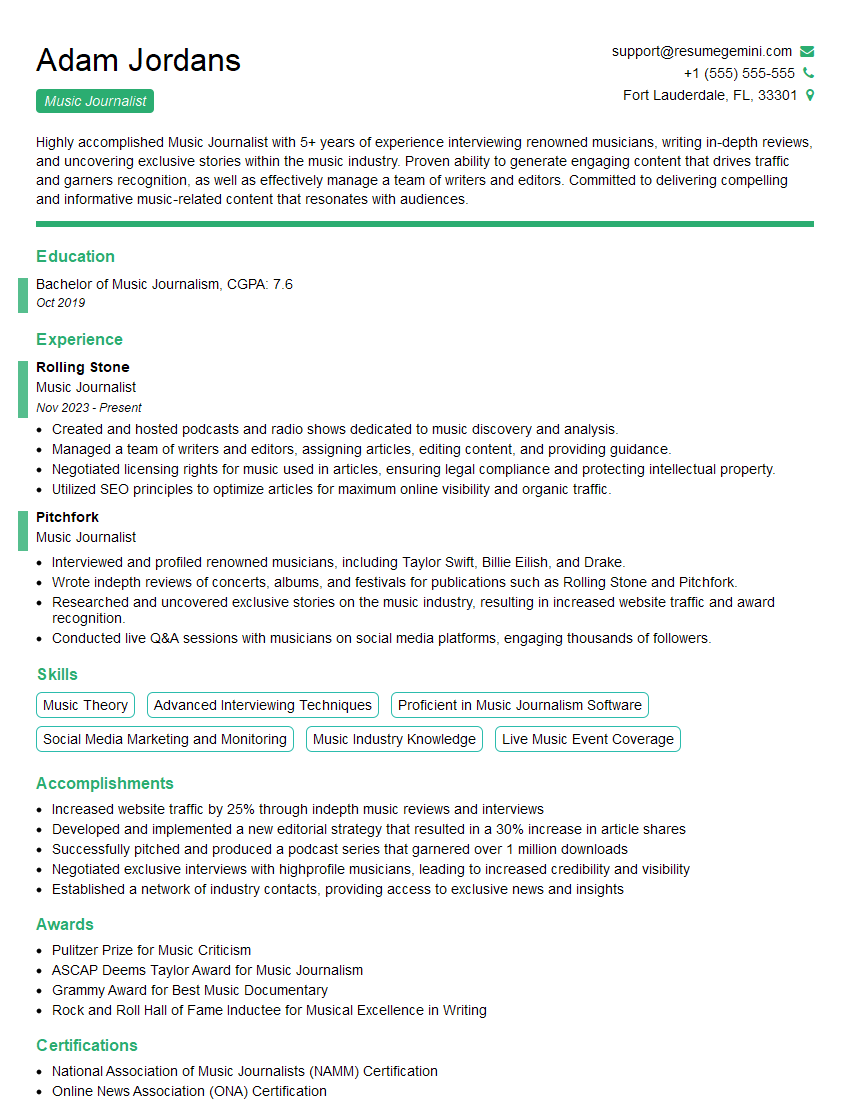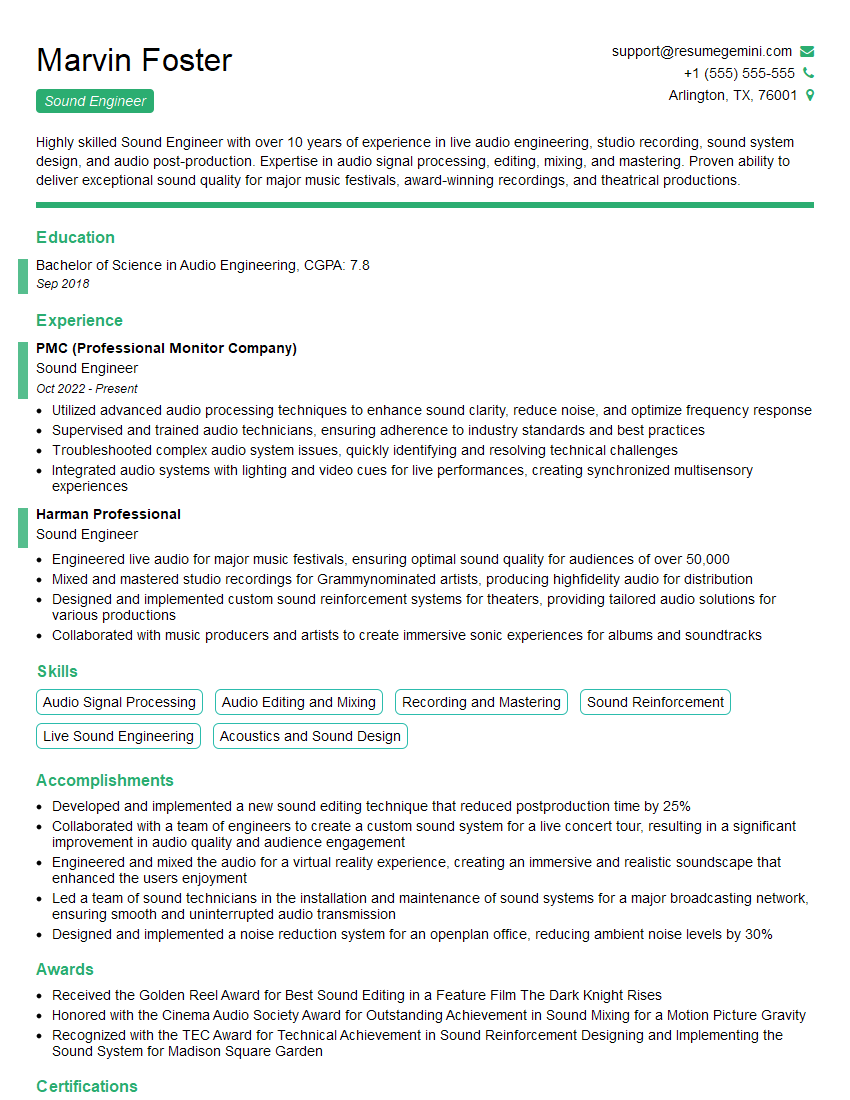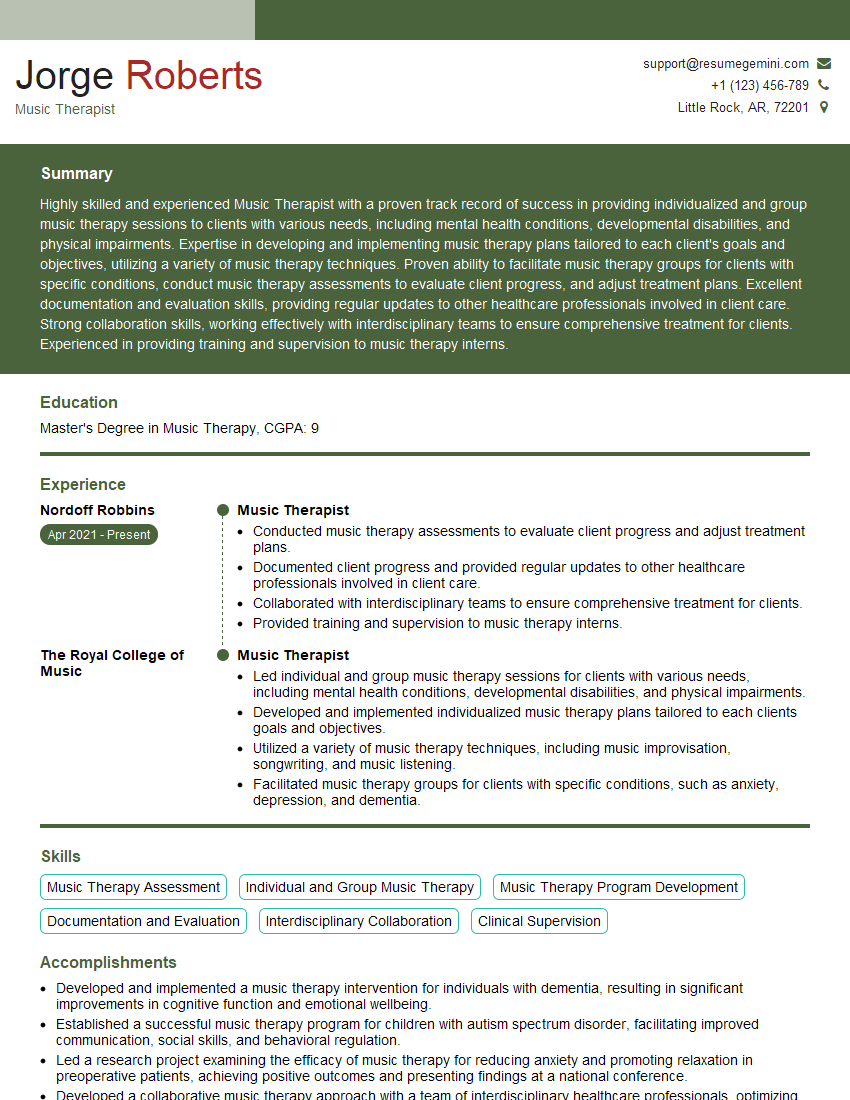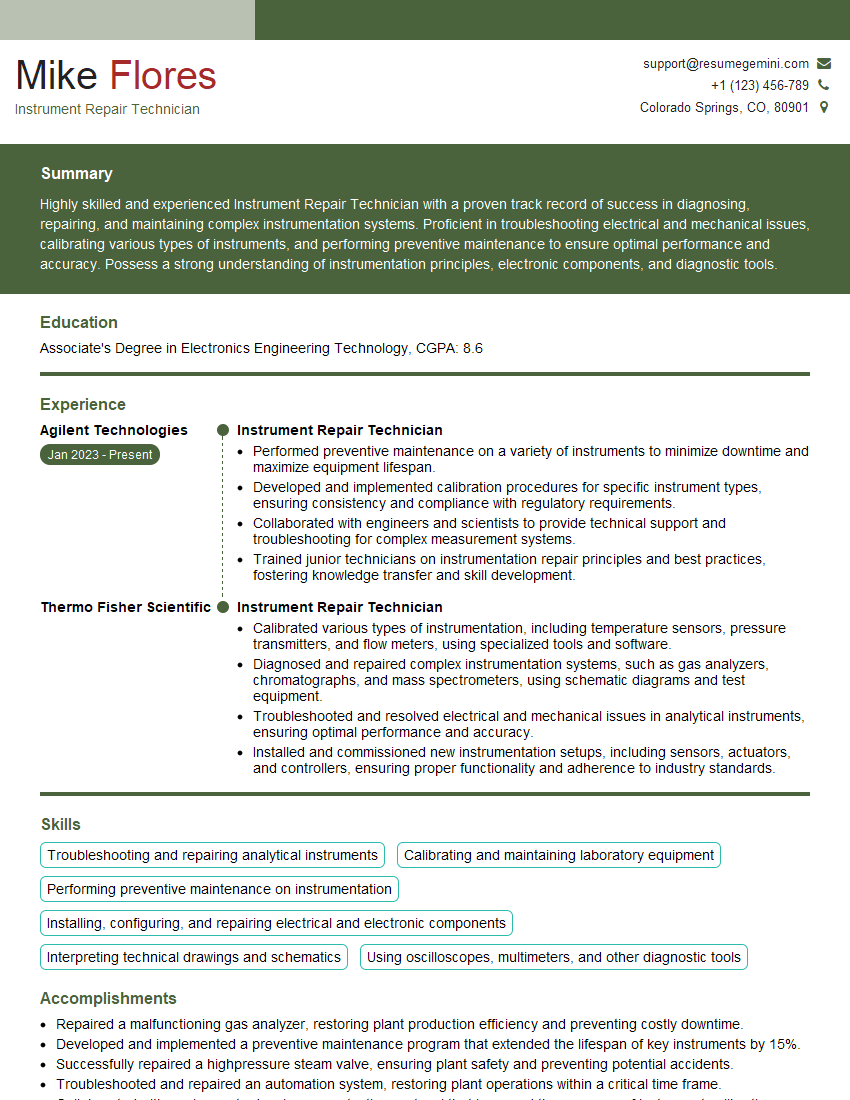Are you ready to stand out in your next interview? Understanding and preparing for Skill in Playing Keyboard, Guitar, Drums, or Bass Guitar interview questions is a game-changer. In this blog, we’ve compiled key questions and expert advice to help you showcase your skills with confidence and precision. Let’s get started on your journey to acing the interview.
Questions Asked in Skill in Playing Keyboard, Guitar, Drums, or Bass Guitar Interview
Q 1. Explain the difference between major and minor scales.
The difference between major and minor scales lies primarily in the arrangement of their intervals – the distances between notes. Both are seven-note scales, but the characteristic sound that distinguishes them comes from the placement of their 3rd, 6th, and 7th degrees.
A major scale is characterized by a bright, happy sound. Its intervals are: whole step, whole step, half step, whole step, whole step, whole step, half step. For example, the C major scale is C-D-E-F-G-A-B-C. The third degree is a major third (four semitones) above the root, the sixth is a major sixth (nine semitones), and the seventh is a major seventh (eleven semitones).
A minor scale generally sounds more somber or melancholic. There are three main types: natural, harmonic, and melodic. The natural minor scale uses the intervals: whole step, half step, whole step, whole step, half step, whole step, whole step. The A natural minor scale is A-B-C-D-E-F-G-A. Notice how the third is a minor third (three semitones) above the root, significantly altering the overall feel compared to major.
The harmonic minor scale alters the 7th degree, creating a leading tone that pulls strongly towards the root, and the melodic minor scale modifies both the 6th and 7th degrees depending on whether ascending or descending.
Q 2. Describe your experience with music notation software (e.g., Sibelius, Finale).
I have extensive experience with Sibelius, using it for composing, arranging, and notating music for various projects. I’m proficient in creating scores, inputting melodies and harmonies, adding articulations and dynamics, and generating various print layouts. I find its intuitive interface and powerful features invaluable for precise notation and clean score presentation. I’ve used it for creating everything from solo pieces to full orchestral scores, and it’s allowed me to refine my understanding of musical structure and notation conventions.
For instance, I recently used Sibelius to create a full score for a chamber ensemble piece. The software’s ability to manage multiple staves and instrument parts simultaneously streamlined the process significantly, and its playback functionality allowed for quick and easy adjustments to the score based on the audible results.
Q 3. What are your preferred methods for practicing your instrument?
My practice methods are varied and adapt to the specific challenges of the piece I’m working on. I believe in a balanced approach incorporating:
- Technical Exercises: Scales, arpeggios, and etudes form the foundation, ensuring fluency and dexterity.
- Targeted Practice: Identifying weak areas within a piece (e.g., a tricky passage or rhythmic section) and focusing on those until mastery is achieved. This is often done through slow, deliberate practice, gradually increasing speed and accuracy.
- Musicality and Expression: I always focus on phrasing, dynamics, and articulation to bring the piece to life, moving beyond just technical accuracy.
- Performance Practice: Regularly playing through the complete piece (even if imperfectly) helps build confidence and identify areas where further work is needed. This simulates the performance environment and helps internalize the piece.
- Listening and Analysis: Carefully listening to recordings of the piece, both by myself and professional musicians, helps understand the composer’s intent and explore different interpretative approaches.
I regularly assess my progress and adjust my practice routine accordingly. For example, If I’m struggling with legato phrasing, I’ll dedicate more time to specific legato exercises before tackling the challenging section in the piece itself.
Q 4. How do you approach learning a new piece of music?
Learning a new piece is a multi-stage process:
- Initial Analysis: I begin by carefully studying the score, identifying the key signature, time signature, and overall form. I’ll listen to recordings to understand the composer’s intentions.
- Section-by-Section Approach: I usually break down complex pieces into smaller sections. This makes the task less daunting and allows for focused practice on specific challenges.
- Slow and Deliberate Practice: I start by playing each section very slowly, focusing on accuracy, rhythm, and proper fingering.
- Gradual Increase in Tempo: As I gain proficiency, I gradually increase the tempo, always ensuring that accuracy is maintained.
- Memorization: Depending on the context, memorization might be a goal. I use techniques such as chunking (breaking the piece into smaller memorable sections) and repetition to help with memorization.
- Refining the Performance: Finally, I focus on expressive aspects, such as dynamics, articulation, and phrasing, shaping the performance to reflect the musical character of the piece.
For example, when learning a challenging sonata, I might spend several days focusing on just the first movement before moving on to the next. This prevents overwhelming myself and promotes a more efficient learning process.
Q 5. Discuss your understanding of rhythm and time signatures.
Rhythm is the organization of sound and silence in time. It’s the pulse and groove that gives music its energy and feel. A basic rhythmic unit can be a beat, a note, or a rest, and these units are organized into patterns and phrases.
Time signatures are notations that indicate the number of beats per measure (the top number) and the type of note that receives one beat (the bottom number). For instance, 4/4 time (common time) means four quarter notes per measure, while 3/4 time signifies three quarter notes per measure. Different time signatures create diverse rhythmic feels. A 6/8 time signature, for example, often creates a swing feel. Understanding time signatures is crucial for accurately interpreting and performing music.
My experience working in various genres has reinforced my understanding of the interplay between rhythm and time signatures. Jazz, for example, often involves complex rhythmic syncopation within a relatively simple time signature. Classical music may employ more straightforward rhythmic patterns but with intricate metrical variations.
Q 6. Describe your experience with different musical genres.
My musical journey has exposed me to a wide range of genres, each offering unique challenges and rewards. I’ve worked extensively with classical music, mastering the intricacies of Bach, Beethoven, and Mozart. This experience honed my technical skills and deepened my understanding of musical form and structure.
I also have significant experience with jazz, developing improvisational skills and learning to navigate complex harmonic progressions. This genre demands a high degree of rhythmic precision and creative spontaneity.
Beyond these, I’ve explored other genres such as rock, pop, and folk music. This has allowed me to broaden my musical palette and adapt my playing to various stylistic conventions. Each genre enhances my overall musicianship and understanding of musical expression.
Q 7. Explain the concept of harmony and its role in music.
Harmony refers to the simultaneous combination of notes, creating chords and progressions that support the melody. It provides the foundation for musical structure and emotional impact.
Chords are built using intervals (the distance between notes). The most basic chords are triads, comprising three notes (root, third, and fifth). These triads can be major, minor, augmented, or diminished, each possessing a unique character. Chords form the building blocks of harmonies, and their relationships to one another create the framework of musical pieces.
Harmony is crucial for musical storytelling. Major chords typically convey joy and brightness, while minor chords evoke sadness or melancholy. The progression of chords helps build tension and release, creating dynamic changes in a composition. Understanding harmony is essential for composing, arranging, and improvising effectively. For instance, a jazz musician must have a deep grasp of harmony to create sophisticated improvisations over complex chord changes. Similarly, a composer relies on harmony to shape the emotional narrative of a piece.
Q 8. How do you handle stage fright or performance anxiety?
Stage fright is a common experience for musicians, but it’s manageable. My approach is multifaceted. Firstly, thorough preparation is key. The more comfortable I am with the material, the less anxious I become. This involves countless hours of practice, focusing not just on technical proficiency but also on the emotional expression of the piece. Secondly, I utilize visualization techniques. Before a performance, I mentally rehearse the entire experience, from walking on stage to the final note, imagining a successful and engaging performance. This helps to reduce the element of surprise and build confidence. Thirdly, I focus on controlled breathing exercises and mindfulness techniques to calm my nerves immediately before going on stage. Deep, slow breaths help regulate my heart rate and reduce the physical manifestations of anxiety. Finally, I’ve learned to embrace the energy of the audience; channeling their positive vibes into my performance helps to transform nervous energy into excitement. It’s about remembering that the audience is there to enjoy the music, and their support is a source of strength.
Q 9. What are your strengths and weaknesses as a musician?
My greatest strength lies in my improvisational skills and ear for harmony. I can quickly adapt to different musical contexts and create compelling solos or accompaniments on the fly. I’ve honed this ability through years of jamming with other musicians and exploring diverse musical styles. A weakness, however, has been my tendency to over-practice certain sections to the detriment of the overall balance and flow of a piece. I’m actively working on this by focusing more on mindful practice, prioritizing quality over quantity and using a metronome to improve my timing and rhythm.
Q 10. Describe your experience working with other musicians in a band or ensemble.
Collaborating with others is fundamental to my musical journey. In my previous band, ‘The Sonic Bloom’, we worked through a structured process. We started with individual contributions – composing our own parts – then met for rehearsals where we meticulously arranged the songs, focusing on dynamics, interplay, and transitions. Communication was crucial; we held open discussions, listened to each other’s ideas with respect, and always prioritized the overall sonic landscape. Conflict resolution involved compromise and finding common ground. For example, when disagreements arose about the tempo of a song, we’d compromise by trying several variations, recording them, and collectively deciding which best captured the song’s essence. This collaborative approach cultivated a strong bond and allowed us to create music that was truly greater than the sum of its parts.
Q 11. Explain your process for composing or arranging music.
My composing process begins with an idea – often a melody, a rhythm, or a harmonic progression that sparks my imagination. This initial spark might come from anywhere: a conversation, a dream, or even the sounds of the city. I then develop this idea through experimentation, usually starting with a piano or guitar. I record these initial sketches, allowing me to revisit and refine them later. The arrangement phase involves adding layers and textures, considering the instrumentation, dynamics, and overall structure of the piece. I often utilize music notation software like Sibelius or Logic Pro to arrange complex pieces, enabling me to manipulate different elements precisely. I frequently iterate on the arrangement, listening critically and making adjustments to ensure the piece flows seamlessly and conveys the intended emotions. I believe in finding a balance between structure and improvisation; allowing myself space to explore and incorporate unexpected elements while maintaining a strong overall framework.
Q 12. How do you maintain your instrument and ensure its optimal condition?
(Assuming the instrument is a guitar) Maintaining a guitar involves regular cleaning and adjustments. After every playing session, I wipe down the strings and body with a microfiber cloth to remove sweat and dust. I also regularly change the strings – every 2-3 weeks, depending on usage – to maintain optimal tone and playability. Yearly professional setup is essential to ensure the guitar’s intonation, action (string height), and neck relief are properly adjusted. I store my guitar in a climate-controlled environment, away from direct sunlight and extreme temperature fluctuations to prevent damage to the wood and finish. In addition, I inspect the guitar regularly for any signs of wear or damage, addressing any issues promptly to prevent further problems. This proactive approach ensures the instrument remains in peak condition, maximizing its lifespan and performance.
Q 13. Describe your experience with recording and mixing music.
My experience with recording and mixing is extensive. I’m proficient in using Digital Audio Workstations (DAWs) such as Pro Tools and Ableton Live. I understand the importance of microphone placement, signal processing (EQ, compression, reverb), and mixing techniques to create a polished and professional-sounding recording. In recording, I prioritize capturing a clear and natural sound, aiming for minimal unwanted noise. During mixing, I focus on achieving a balanced sound where each instrument has its place in the mix, creating clarity and depth without muddiness. I frequently employ techniques such as sidechaining and automation to add movement and dynamism to the music. Mastering is a separate process that I typically entrust to a professional mastering engineer, as it requires specialized equipment and experience to ensure the final product is optimized for various playback systems.
Q 14. What are your preferred methods for improving your musical skills?
My approach to improving is multifaceted. Firstly, I engage in regular, focused practice, targeting specific weaknesses identified through self-assessment or feedback from other musicians. I utilize different practice methods – scales, arpeggios, chord studies, and improvisational exercises – to develop technique, ear training, and musicality. Secondly, I constantly seek inspiration from different musical genres and artists, attending concerts, listening to recordings, and analyzing the work of musicians I admire. Thirdly, I actively seek out feedback from trusted musicians and teachers. Constructive criticism, even if it’s difficult to hear, helps me identify areas for improvement and refine my skills. Finally, I challenge myself by performing regularly, both in live settings and recording projects. Performance is a vital testing ground, allowing me to identify areas that need further work and to build confidence in my abilities.
Q 15. How familiar are you with music theory concepts such as counterpoint and fugue?
Counterpoint and fugue are fundamental concepts in Western music theory related to the interplay of independent melodic lines. Counterpoint involves two or more melodic voices that are harmonically independent yet interwoven, creating a rich texture. Think of it like a conversation between two singers – each with their own distinct tune, yet blending harmoniously. Fugue, a more complex form, is a contrapuntal composition where a single theme (the subject) is introduced in different voices, often in imitation. I’ve studied both extensively, analyzing works by Bach, whose fugues are masterpieces of contrapuntal writing. My understanding extends beyond simple imitation; I can analyze the development of the subject, countersubjects, and episodes, understanding how composers manipulate these elements to create tension and release. My experience in arranging for multiple instrumental ensembles has directly benefited from this deep understanding of counterpoint and fugal techniques.
Career Expert Tips:
- Ace those interviews! Prepare effectively by reviewing the Top 50 Most Common Interview Questions on ResumeGemini.
- Navigate your job search with confidence! Explore a wide range of Career Tips on ResumeGemini. Learn about common challenges and recommendations to overcome them.
- Craft the perfect resume! Master the Art of Resume Writing with ResumeGemini’s guide. Showcase your unique qualifications and achievements effectively.
- Don’t miss out on holiday savings! Build your dream resume with ResumeGemini’s ATS optimized templates.
Q 16. Discuss your experience with improvisation.
Improvisation is the spontaneous creation of music. For me, it’s a cornerstone of musical expression. My improvisational skills are honed through years of practice on both guitar and keyboard. I approach improvisation by grounding myself in a harmonic framework – often building upon chord progressions or scales relevant to the piece. I rely heavily on ear training and an understanding of musical phrasing and melodic development. I frequently use motifs and rhythmic patterns which I then vary and develop in real time. For example, in a jazz setting, I might start with a simple blues riff and gradually introduce variations, incorporating chromaticism, altered chords, and unexpected rhythmic shifts to maintain audience engagement. Even within structured arrangements, I look for opportunities to inject creative, improvised elements to make the performance fresh and dynamic.
Q 17. Explain the importance of dynamics and articulation in musical performance.
Dynamics and articulation are crucial for conveying emotion and meaning in music. Dynamics refer to the volume of the music—from pianissimo (very soft) to fortissimo (very loud). Articulation refers to how individual notes are played, impacting their character and the overall feel. Techniques like staccato (short, detached notes), legato (smooth, connected notes), and accents (emphasized notes) shape the musical narrative. Consider a classical piece: a delicate pianissimo passage might create a sense of vulnerability, while a powerful fortissimo can convey triumph or drama. Similarly, the use of staccato in a fast passage can create a sense of urgency, while legato in a slow melody can evoke a feeling of serenity. I strive to use both dynamics and articulation not just technically, but to enhance the emotional impact of the music.
Q 18. Describe your understanding of different musical forms (e.g., sonata, rondo).
Musical forms provide a structure for musical compositions. A sonata form, for example, typically consists of three sections: exposition (introducing the main themes), development (transforming and developing the themes), and recapitulation (restatement of the themes). A rondo is characterized by a recurring main theme (the ‘A’ section) interspersed with contrasting sections (B, C, etc.). Understanding these forms helps musicians and listeners alike to follow the musical narrative and appreciate the composer’s artistry. Knowing the typical characteristics of a sonata allows me to anticipate harmonic shifts and structural changes, enhancing both performance and interpretation. Analyzing different forms has sharpened my ability to interpret, analyze, and arrange music across various genres.
Q 19. How do you adapt your playing style to different musical settings?
Adapting to different musical settings is essential. My approach depends on several factors, including the genre, the instrumentation, and the overall style. Playing in a rock band requires a different approach compared to a classical orchestra or a jazz trio. In a rock context, I emphasize rhythmic precision, powerful dynamics, and a strong sense of groove. In classical settings, accuracy, nuanced phrasing, and articulation take precedence. In jazz, improvisational skills, and a deep understanding of harmony and rhythmic phrasing become paramount. I am comfortable navigating these varied contexts, constantly adjusting my playing style to fit the musical environment and the needs of the ensemble.
Q 20. What are your thoughts on the use of technology in music production?
Technology has revolutionized music production. Digital audio workstations (DAWs) like Logic Pro X or Ableton Live are invaluable tools for recording, editing, mixing, and mastering music. Software instruments and effects plugins provide endless creative possibilities, allowing musicians to craft soundscapes that were unimaginable a few decades ago. However, I believe that technology should enhance, not replace, the core elements of musical expression. While I use technology extensively for recording and production, I always prioritize the emotional and artistic aspects of the music, ensuring the technology serves the music, not the other way around. My experience includes both analog and digital recording techniques, allowing me a holistic approach to music production.
Q 21. How do you approach troubleshooting technical issues during a performance?
Troubleshooting technical issues during a performance requires a calm and methodical approach. My first step is to identify the problem: Is it a broken string? A malfunctioning amplifier? A problem with my instrument’s electronics? Once identified, I attempt to find a quick fix. A broken string might require a spare, a faulty amplifier could necessitate switching to a backup, or a technical problem with my instrument might require switching to another. Preparation is key: I always bring extra strings, cables, and battery packs and ensure my instruments are properly maintained. Prioritizing quick and efficient problem-solving helps minimize disruption to the performance and maintain audience engagement. My experience with live performances over the years has prepared me for such unexpected situations, allowing me to address them swiftly and professionally.
Q 22. Describe your experience using amplification and sound reinforcement equipment.
My experience with amplification and sound reinforcement spans over a decade, encompassing everything from small coffee shop gigs to larger venue performances. I’m proficient in operating a wide range of equipment, including various microphone types (dynamic, condenser, ribbon), mixing consoles (both analog and digital), power amplifiers, and speaker systems. I understand the importance of proper microphone placement for optimal sound capture, EQ adjustments to tailor the sound to the venue’s acoustics, and the use of effects processors like compressors, reverbs, and delays to shape the overall tone. For example, when playing in a jazz trio in a smaller venue, I found that a condenser microphone positioned close to the guitar’s soundhole provided a warmer, more intimate tone, while a larger venue required a more robust dynamic microphone with appropriate EQ adjustments to combat feedback and ensure clarity at higher volumes. I’m also familiar with monitor mixing, ensuring I have an appropriate mix tailored to my individual needs on stage. I’ve worked extensively with both PA systems and backline amplification, troubleshooting issues and optimizing sound quality for different musical styles and venues.
Q 23. What is your experience with music editing and audio processing software?
My proficiency in music editing and audio processing software extends to several industry-standard programs. I’m highly experienced with DAWs (Digital Audio Workstations) such as Ableton Live and Logic Pro X, and I’m comfortable using them for multi-track recording, mixing, mastering, and even MIDI sequencing. I understand the principles of digital signal processing (DSP), including equalization (EQ), compression, reverb, delay, and other effects. For instance, I’ve used Logic Pro X’s extensive plugin library to meticulously craft the sound of my guitar on several recordings, employing techniques such as noise reduction, gate processing to remove unwanted artifacts, and multi-band compression to ensure a balanced and dynamic sonic outcome. My skillset also includes familiarity with audio editing software like Audacity for more basic tasks, like waveform editing and noise reduction. I understand the importance of proper file management, metadata tagging and archiving.
Q 24. Describe your understanding of audio signal flow in a recording studio.
Understanding audio signal flow in a recording studio is crucial for effective recording and mixing. It’s essentially a chain reaction: the signal originates from the instrument (e.g., guitar), travels through the microphone (or direct input), then into a preamplifier which boosts the signal and shapes its impedance, followed by the signal routing through the audio interface into the DAW. Within the DAW, we have various processing options (EQ, compression, effects), then signal routing to different tracks and buses. After mixing, the final audio passes through the mastering stage where additional processing enhances the overall quality and loudness.
For example, in a recording session, a poorly chosen microphone or inadequate pre-amplification could dramatically affect the signal’s quality. Equally, improper gain staging throughout the signal chain could lead to distortion or a weak signal. This knowledge is crucial for troubleshooting issues and making informed decisions during recording.
Q 25. How do you handle constructive criticism regarding your musical performance?
Constructive criticism is invaluable for growth. I approach it as an opportunity to refine my skills and understand areas for improvement. I actively listen to feedback, asking clarifying questions if needed to ensure I fully comprehend the points raised. I analyze the critique objectively, separating valid criticisms from subjective opinions. Then, I focus on implementing the actionable suggestions. For instance, a critic once pointed out that my guitar solos lacked rhythmic variation. I addressed this by studying rhythmic patterns in various musical styles and actively practicing incorporating those patterns into my playing. I view constructive criticism not as an attack, but as guidance for becoming a better musician.
Q 26. What are your long-term goals as a musician?
My long-term goals are multifaceted. Professionally, I aspire to establish myself as a versatile and sought-after session musician, working on diverse projects ranging from studio recordings to live performances. I aim to collaborate with other talented musicians, potentially forming my own band or ensemble. Beyond that, I want to contribute to the musical community through teaching and mentorship, sharing my passion and knowledge with aspiring musicians. I also want to compose and produce my own original music, releasing my own album and touring if the opportunity arises. Ultimately, my goal is to make a meaningful contribution to the world of music, constantly learning and evolving as an artist.
Q 27. Describe a time you had to overcome a significant challenge in your musical career.
One significant challenge was overcoming performance anxiety during my early career. I used to freeze on stage, even during smaller gigs. To overcome this, I implemented several strategies: Firstly, I practiced extensively, familiarizing myself with my material so thoroughly that I felt confident in my ability to perform even if I forgot parts of the song. Secondly, I focused on visualization techniques, mentally rehearsing successful performances to reduce the anxiety. Finally, I started by playing small gigs for supportive audiences to gradually build my confidence. This multifaceted approach significantly reduced my stage fright, enabling me to become a more comfortable and confident performer.
Q 28. How do you stay current with the latest trends and innovations in music?
Staying current is vital. I utilize several methods to keep abreast of the latest trends: I actively listen to a wide variety of music across various genres, attending concerts and festivals whenever possible. I subscribe to music blogs, podcasts, and online publications that provide insightful commentary and reviews of new artists and technologies. I engage with online music communities, participating in forums and discussions where musicians share their experiences and insights. I regularly watch online tutorials and masterclasses, enhancing my technical skills and learning new techniques. This combination of active listening, engaging with online communities, and utilizing educational resources keeps my musical knowledge and skills current and relevant.
Key Topics to Learn for a Skill in Playing Keyboard, Guitar, Drums, or Bass Guitar Interview
- Musical Theory Fundamentals: Understanding scales, chords, rhythm, and music notation is crucial. Practice applying these concepts to various musical styles.
- Instrument-Specific Techniques: Mastering essential techniques like finger exercises, strumming patterns (guitar), sticking techniques (drums), scales and arpeggios (keyboard/guitar), and rhythmic accuracy is key. Showcase your proficiency through prepared examples.
- Improvisation and Creativity: Demonstrate your ability to improvise melodies, solos, or rhythmic variations. Highlight your understanding of musical phrasing and dynamics.
- Ensemble Playing and Collaboration: Discuss your experience playing with others, emphasizing your ability to listen, adapt, and contribute to a group performance. If applicable, mention specific genres or styles you excel in.
- Aural Skills: Develop your ability to recognize intervals, chords, and melodies by ear. This demonstrates a deep understanding of music beyond just technical proficiency.
- Ear Training and Sight-reading: Practice transcribing music by ear and sight-reading musical scores. This shows adaptability and musical literacy.
- Music History and Styles: Familiarize yourself with the history and characteristics of different musical genres relevant to your instrument and desired role. Demonstrate your breadth of musical knowledge.
- Problem-Solving and Adaptability: Be prepared to discuss how you approach challenges in your musical practice and performances, demonstrating your resilience and learning agility.
Next Steps
Mastering your instrumental skills opens doors to diverse and rewarding career paths, from performance and teaching to music production and composition. To maximize your job prospects, a well-crafted resume is essential. Building an ATS-friendly resume that highlights your unique skills and experience is crucial for getting noticed by potential employers. ResumeGemini is a trusted resource to help you create a professional and impactful resume that showcases your abilities effectively. Examples of resumes tailored to showcasing skills in playing keyboard, guitar, drums, or bass guitar are available to guide you.
Explore more articles
Users Rating of Our Blogs
Share Your Experience
We value your feedback! Please rate our content and share your thoughts (optional).
What Readers Say About Our Blog
Hello,
We found issues with your domain’s email setup that may be sending your messages to spam or blocking them completely. InboxShield Mini shows you how to fix it in minutes — no tech skills required.
Scan your domain now for details: https://inboxshield-mini.com/
— Adam @ InboxShield Mini
Reply STOP to unsubscribe
Hi, are you owner of interviewgemini.com? What if I told you I could help you find extra time in your schedule, reconnect with leads you didn’t even realize you missed, and bring in more “I want to work with you” conversations, without increasing your ad spend or hiring a full-time employee?
All with a flexible, budget-friendly service that could easily pay for itself. Sounds good?
Would it be nice to jump on a quick 10-minute call so I can show you exactly how we make this work?
Best,
Hapei
Marketing Director
Hey, I know you’re the owner of interviewgemini.com. I’ll be quick.
Fundraising for your business is tough and time-consuming. We make it easier by guaranteeing two private investor meetings each month, for six months. No demos, no pitch events – just direct introductions to active investors matched to your startup.
If youR17;re raising, this could help you build real momentum. Want me to send more info?
Hi, I represent an SEO company that specialises in getting you AI citations and higher rankings on Google. I’d like to offer you a 100% free SEO audit for your website. Would you be interested?
Hi, I represent an SEO company that specialises in getting you AI citations and higher rankings on Google. I’d like to offer you a 100% free SEO audit for your website. Would you be interested?
good
